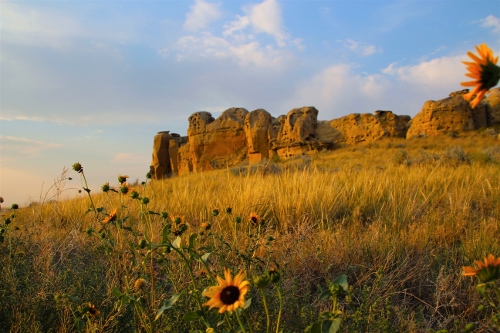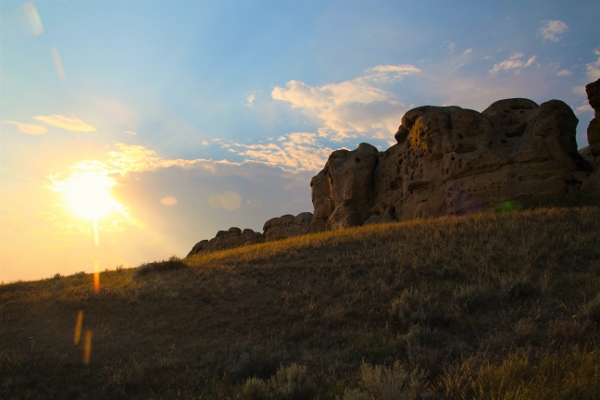Writing-On-Stone is a provincial park in the southeast corner of Alberta near the Montana border. Vast open prairies meet endless sky before giving way to an otherworldly landscape in the Milk River Valley. The park is famous for the largest collection of First Nation rock art on the Great Plains of North America. Situated in the heart of the Blackfoot’s traditional territory the entire area holds great cultural and spiritual significance for their People. Known as Áísínai’pi in the Blackfoot language, the park is aptly named as it roughly translates to “it is pictured/written”.

There are over 1,000 pieces of artwork that have been found within the park and some are estimated to be over 5,000 years old. There is archaeological evidence that First Nation People camped in the valley as long as 3,500 years ago, but it remains unclear when the first appearance of rock art truly was. Researchers believe that the Blackfoot People created the majority of the artwork, but other groups such as the Cree, Gros Ventre, Assiniboine, Crow, Kutenai, and Shoshone are thought to have also contributed to the valley’s ample collection. Many of the petroglyphs that were created before the introduction of stone tools were scratched or incised onto the sandstone cliffs using antlers or bones. The pictographs were painted using red ochre, which is crushed iron ore mixed with animal fat or water. Sometimes even a piece of charcoal was used to create a painting. Unfortunately there is no technique that can accurately date rock art, instead researchers can approximate the age based on objects depicted in the artwork or by analyzing changes in rock art styles. Much of the rock art is still shrouded in mystery as the exact meaning for many pieces may be lost to time. Using a variety of methods such as legends, archaeology, historical records, and the help of First Nation Elders, researchers can hypothesize some of the meanings behind the art. It is believed that much of the artwork was probably ceremonial, created during different rituals such as vision quests.


The park is also home to a historic North West Mounted Police (NWMP) Post that was originally constructed in 1889. The post sits at the mouth of Police Coulee next to the Milk River and was occupied for twenty-nine years before closing in 1918. It was one in a series of police outposts built with the intention of combating whiskey smuggling and horse raiding that was reportedly happening in Canada’s unruly western frontier. Once the post had been established the officers soon realized that the aforementioned crimes were highly exaggerated and they were forced to adopt more tedious tasks like fighting grass fire, herding U.S. cattle back across the border, and riding long patrols along their assigned boundary. The post reached its peak in 1897 with twelve horses, five Mounties, and two hired range riders, but from that point the post slowly declined until just a single Mountie was stationed there in 1905. In 1918 the federal government closed all police posts along the border as the fear of criminal activity had been minimized. This particular post shuttered its doors in May of that year and was burnt to the ground a short time later by unknown arsons. It wasn’t until 1975, in conjunction with the NWMP (now the Royal Canadian Mounted Police or RCMP) centennial celebrations that the post was rebuilt according to original specifications.

A short hike up Police Coulee from the outpost reveals Signature Rock. It was here that many of the Mounties who were stationed at the post carved their names into the soft sandstone cliffs. Some are elaborate carvings that obviously took a lot of time and energy, while others are more simplistic. Although carving your name into the cliffs is now illegal these carvings are considered historical graffiti and are embraced as part of the park’s history. Much like Dinosaur Provincial Park, large portions of Writing-On-Stone are classified as an Archaeological Preserve, meaning it’s off-limits to the public unless accompanied by a guide. Signature Rock and the NWMP Post are both found within the preserve, but the timing of my visit couldn’t have been better as they opened the post to visitors for one day as part of a pilot program with the hope of offering interpretive tours more frequently. The guides did a fantastic job offering insight into the history of the area, explaining what life was like for Mounties stationed at the post, and providing detailed information on a few of the men whose names are inscribed on the rock.

Like the police post much of the artwork is also located within the Archaeological Preserve and is only visible by participating in a guided Rock Art Tour. My guide was an Elder from the Kainai First Nation and was a wealth of knowledge about the various artwork we saw. She offered insight to many of the pieces and provided cultural interpretations about context. Luckily not all of the artwork is off-limits. There are several pieces available to the public, most of which can be found along the Hoodoo Trail. You will find both petroglyphs and pictographs as well as the most complex and extensive rock art panel in the entire park; the Battle Scene. The large panel contains over 250 different characters, was likely carved in the late 1800’s, and may depict the ‘Retreat Up The Hill’ battle as described by an Aamsskáápipikáni Elder named Bird Rattle.

The park is a marvel to behold in both landscape and history. You can almost feel a change in the energy as you enter the valley for the first time. Traditional beliefs hold that all worldly things, even rocks, harbour supernatural powers. This remarkable valley with its unique geology contains powerful spirits that could benefit those that came to appease them. Áísínai’pi is sacred land and it’s abundantly clear that Writing-On-Stone was a place of great cultural and spiritual significance and still continues to be till this day.

For additional information about Writing-On-Stone please visit the Alberta Parks website. For more photos and information about the artwork at Writing-On-Stone (as well as other rock art sites) please visit this blog post titled, First Nation Rock Art. You can also learn more about early NWMP outposts by reading these stories about Fort Whoop-Up, Fort Calgary, and Fort Normandeau. Laastly, I have done two previous stories about rock art, which you can read by following these links: Paintings From The Past and Hunting History.




